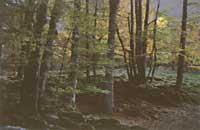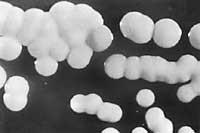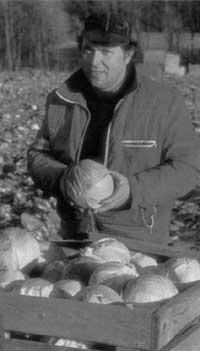Hayedos de Nafarroa Garaia: a treasure that cannot escape the clutches of pollution
2003/02/01 Amores Olazagirre, Gustavo Iturria: Elhuyar aldizkaria
Among them, besides those traditionally studied (drought, temperature, availability of food, pathogens, etc. ). ), scientists are increasingly attentive to the pollutants of the air.
The importance of the hayeds of Nafarroa Garaia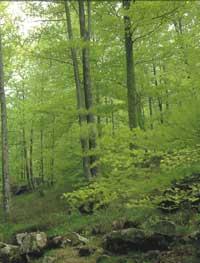
Among the forests of Alta Navarra, the hayedos are the ones that occupy the most extension. Recent studies indicate that the beech is expanding. At present, the beech occupies an area of 143,280 hectares in Upper Navarre, which means about 25% of the beech trees of the entire Iberian Peninsula.
The hayeds are part of the landscape of the Cantabrian and Pyrenean area of Navarre, as well as the northern margins of the merindad of Estella and Navarre Media. These forests are traditionally associated with uses and customs in the aforementioned regions, with added cultural values, in addition to their economic utility.
Besides this general importance, in Nafarroa Garaia there are special hayedos of enormous value. One of them is the Iratic, one of the most important forests in Europe. Another example can be found in the valley of Belagua: Aztaparreta forest, considered as the example of the Virgin of the Hayedo.
For the reasons discussed above, the Department of Chemistry and Edafology of the University of Navarra proceeded to analyze the situation of the Nafarroa Garaia hayeds. In particular, we wanted to analyze its current situation in terms of food and pollution. To do this, 30 beech plantations were selected within the region known as Mendialdea, with the aim of maximizing the beech trees of Nafarroa Garaia (Figure 1). For each sampling point, 6 trees were selected and the macro-food and microfood content of the leaves was analyzed and the so-called Forest Damage Inventory was developed. Also, surface soil samples were collected in the environment of the beech trunk to determine complete contents of heavy metals, removable fractions, pH and content in organic matter.
Below are the most outstanding conclusions of the results obtained.
Beech puff state (defoliation)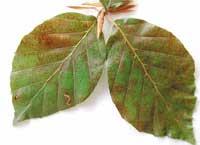
As for the Forest Damage Inventory, the trees analyzed appear to be healthier than the beech trees of many European regions, at least in 1997 the number of damaged beech trees is clearly below the European average. Thus, beech plantations located in Auritz, Larra and Orbaitzeta are the only ones that could be considered affected.
In any case, the analysis of results has indicated that the state of the beech puff with other variables analyzed (age of the trees, slope of the plantations, temperature, amount of rain, food content of the leaves, etc.) Despite showing some level of linkage, it is not a direct consequence of any of them. These results coincide with the hypothesis currently adopted, that the state of the puff of the trees of a forest is the result of a combination of multiple variables (climatological, soil, genetic, pollution, pest attacks, etc. ). ).
Nutritional status of the hayedsThe results obtained on the macro-food content of the beech leaves allow us to conclude that:
The main origin is the underground rock, especially in terms of the elements of calcium, potassium, phosphorus and sulfur. Thus, soil characteristics condition the geographical distribution of the contents of these four foods. However, in the case of potassium there is another main variable that limits the content in the leaves: the amount of rain. Rain, in addition to transporting potassium from the soil to the deep layers, produces a direct loss of this food by contact between leaves and water.
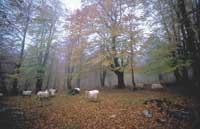
As for magnesium, it should be noted that in addition to the rock under the soil, the origin of its content is the Cantabrian sea. As for nitrogen, the complexity of its biogeochemical cycle makes it practically impossible to find concrete variables that condition the content of this food in the leaves. However, it is very likely that cross-border pollution from the regions located both north and northwest of the studied area (neither in the case of sulfur can this possibility be ruled out). Moreover, taking into account the importance of livestock in the High Navarre Mountain, it can be affirmed that the amount of NH3/NH4+ emitted as a consequence of this activity affects the nitrogen content of the leaves.
Although so far we have talked about the contents of food, the relationships between them are much better indicators of the state of feeding of a tree. Among them, the most appropriate is the N/P ratio, since both nitrogen and phosphorus are specially mixed in physiological functions. Well, considering this parameter, we can affirm that the vast majority of the hayeds analyzed are in good nutritional status.
The other main conclusion drawn from the analysis of the relations between foods is: Unlike many temperate forests in Europe and North America, the hayeds of Nafarroa Garaia are not yet occupied by the N-ase, and nitrogen is the food that continues to limit the growth of the hayeds, aided by the high contents of the rest. This data coincides with the fact that at present, in the analyzed area, the levels of nitrogen sediments do not exceed the critical values calculated for forest ecosystems.
State of contamination of the hayeds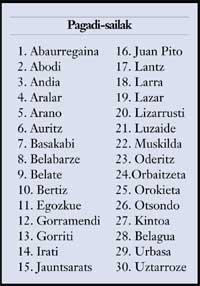
The analysis of the metallic contents of soil and leaf samples allows us to reach the following conclusions:
As for the land, the contamination by lead and copper has been located in the land of all the plantations of hayeds analyzed, and the contamination by zinc has been verified on average or safely. However, lead pollution is the highest of all. The extraordinary importance of this discovery lies in the value of lead as an indicator of air pollution, that is, the detection of lead pollution shows us an indication of general pollution, since the polluting sources do not expel in isolation a harmful species.
In fact, the total lead content of the soil samples analyzed is totally conditioned by the arrival of lead through contamination. Something similar could be said of zinc and copper, but only partially. The removable fractions of the contents of these three elements are conditioned for the same reasons. The rest of the metals analyzed (Cd, Cr and Ni), both in their total content and in their removable fraction, depend on the rock or some intrinsic characteristic of the soil. In any case, we cannot forget that the Nafarroa Garaia hayeds receive small contributions of cadmium and chromium from the west and northwest.
The anthropic contributions of lead and zinc have their origin in industrialized areas located to the west and northwest of the studied area. However, and despite the fact that the procedure followed in this paper does not allow its demonstration, it is not possible to ignore the important influence that traffic should have on the detected lead contamination, knowing that it is the main source of lead worldwide. In the case of copper, however, it is possible that the main source is in European industrialized regions farther north.
However, the content of lead, zinc and copper of the hayedo lands of Alto Navarre have not reached levels for the time being that could damage the development of the microfauna and the mesofauna that lives in the soil, except exceptions (such as the lead content of the lands of some forests located in the north-western quadrant), but yes the cadmium and chromium contents found, although of natural origin. It must be taken into account that these living beings are the most sensitive of the ecosystem regarding heavy metals.
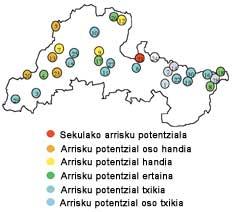
The last great conclusion that the study of soil samples leaves us is that our hayeds have not suffered acidification phenomena.
The results obtained from the analysis of foliar samples confirm, in general, the deduced by the study of the soil, showing the influence of the industrial areas close to the Cantabrian coast.
Both by aggravation of the pollution situation and by a sudden change of the ecosystem, if we analyze from a global perspective the risk that the metallic contents of each series of beech can suppose for the vegetation, we can observe a trend towards the northwest (Figure 2).
Permanent study of a series of hayedsWe also conducted an intensive study of a representative beech from Nafarroa Garaia to complete the research. Specifically, for almost three years, every 15 days rainfall samples were analyzed both inside and outside a series of beech trees located in Auritz (Figure 3), reaching the following conclusions:
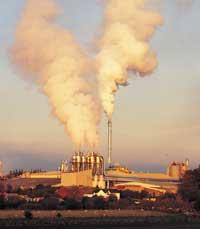
As for the possible acidification of the ecosystem in the long term, the results obtained are worrying, since although the entire deposition of the basic cations, as well as the open field, are one of the largest in Europe, it exceeds the acidifying compounds (nitrogen and sulfur), as it happens throughout the continent. In this regard, it should be noted that the rates of nitrogen sedimentation are much higher than those of sulfur, in line with the trend observed in the European zone in the last two decades.
However, the loss of basic cations in the vegetation, especially of potassium and calcium, due to the rain, diverts both the acidification capacity and the acidity of the water poured inside the forest.
On the other hand, the results suggest that at certain times of the year the plants absorb the nitrate that the rain causes, which could be an indicator that the hayedo analyzed is not found in the N-ase.
As for the origin of the chemical species studied, most of the sodium, chloride, magnesium and potassium collected in open field comes from the Cantabrian Sea, transported by the dominant winds of the northwest. The amount of sodium, chloride, and magnesium collected inside the forest is mainly conditioned by wet deposition, and the processes of exchange with vegetation are practically irrelevant, unlike potassium.
Most of the amount of protons and nitrates collected, from the oxidation of nitrogen oxides emitted by the vehicles, is transported by the rain that arrives with the winds of the north to the section of hayeds of Auritz. However, during the study period there have been a series of episodes related to local pollution, with special incidence in the dry deposition of the ions mentioned and a decrease of the pH of the rain up to values of 4’3.
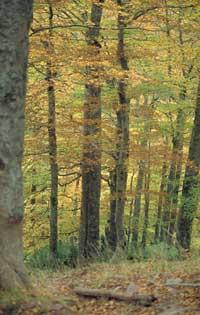
As for calcium and sulfate, they mainly come from the spills of the factories of the District of Pamplona, without forgetting the contribution of aerosols that can come from plaster rich lands located south of Navarre.
Looking to the futureIt is true that since the decline of heavy industry in the regions located to the west and northwest of the Sierra de Navarra Alta, the emissions of heavy metals have been reduced, as well as since the introduction of lead-free gasoline the amount of lead emitted by the vehicles is lower. However, it would be convenient to continue periodically analyzing the contents of heavy metals of our hayeds, since with this work we cannot determine whether the contamination found is old or recent.
In the face of the generalized increase in emissions of nitrogenous compounds, the control of the feeding state of the hayeds and the analysis of the rain should not be interrupted either, since this increase can provoke, besides the saturation of the N of the ecosystems, an acidification that would mobilize some of the heavy metals of the soil.
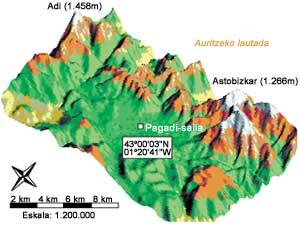
BIBLIOGRAPHY BIBLIOGRAPHY
- Amores Olazagirre, G.Evaluation of the phytosanitary and pollution status of the beech trees of the Foral Community of Navarre by using indicators. Doctoral thesis. 332 pages. 2002.
- De Vries, W., Reinds, G.J. Clap, J.M., Van Leeuwen, E.P., Erisman, J.W.‘Effects of environmental stress on forest crown condition in Europe. Part III: estimation of critical deposition and concentration levels and their exceedances’. Water, Air and Soil Pollution. 119: 363-386. 2000.
- Duquesnay, A., Dupouey, J.L. Clement, A., Ulrich, E., Le Tacon, F.‘Spatial and temporal variability of foliar mineral concentration in beech (Fagus sylvatica) stands in northeastern France’. Tree Physiology. 20: 20: 20 22-13 2000.
- EC-UN/ECE (De Vries, W., Reinds, G.J., van der Salm, C., Draaijers, G.P.J., Bleeker, A., Erisman, J.W. Auée, J., Gundersen, P., Kristensen, H.L., van Dobben, H., de Zwart, D., Derome, J., Voogd, J.C.H., Vel, S.L. ).Intensive Monitoring of Forest Ecosystems in Europe, 2001 Technical Report(EC, UN/ECE 2001, Brussels, Geneva). Page. 177 2001.
- Rademacher, P.‘Atmospheric Heavy Metals and Forest Ecosystems’. CLRTAP. 2001.

Gai honi buruzko eduki gehiago
Elhuyarrek garatutako teknologia




